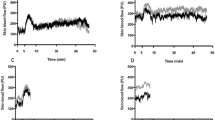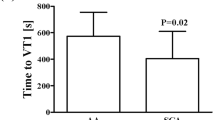Abstract
This study compared the hemorheological profile at rest and in response to a short supramaximal exercise test between sickle cell trait (SCT) carriers and a control group. Eight SCT carriers and eight control subjects performed a ramp exercise test on a cycle ergometer conducted to maximal oxygen uptake \((\dot{V}{\text{O}}_{2{\text{max}}}).\) One week later, they performed a supramaximal exercise test consisting of pedaling for 1 min at 110% \(\dot{V}{\text{O}}_{2{\text{max}}}.\) Blood viscosity (ηb), plasma viscosity (ηp), hematocrit (Hct) and red blood cell (RBC) rigidity were assessed at rest, at the end of exercise and at the 15th, 30th and 60th min of recovery. Exercise increased ηb, ηp and Hct above resting values in both groups and these parameters remained higher until the 15th or 30th min of recovery as compared to resting values. RBC rigidity was unchanged from baseline values in both groups during exercise and recovery. No difference was observed between the two groups for ηp and Hct but ηb and RBC rigidity were higher in the SCT carriers at every time point compared with the control group. The higher RBC rigidity and ηb found in SCT carriers at rest and in response to a brief supramaximal exercise might constitute a risk factor for microcirculatory complications. Indeed, a short supramaximal exercise test may not be completely inoffensive for SCT carriers.




Similar content being viewed by others
References
Ajayi AA (2005) Should the sickle cell trait be reclassified as a disease state? Eur J Intern Med 16:463
Ajmani RS, Fleg JL, Demehin AA, Wright JG, O’Connor F, Heim JM, Tarien E, Rifkind JM (2003) Oxidative stress and hemorheological changes induced by acute treadmill exercise. Clin Hemorheol Microcirc 28:29–40
Ballas SK, Mohandas N (2004) Sickle red cell microrheology and sickle blood rheology. Microcirculation 11:209–225
Baskurt OK, Meiselman HJ (2003) Blood rheology and hemodynamics. Semin Thromb Hemost 29:435–450
Beard MJ, Cardigan R, Seghatchian J, Krailadsiri P, Williamson LM (2004) Variables determining blockage of WBC-depleting filters by Hb sickle cell trait donations. Transfusion 44:422–430
Bishop D (2001) Evaluation of the Accusport lactate analyser. Int J Sports Med 22:525–530
Brandao MM, Fontes A, Barjas-Castro ML, Barbosa LC, Costa FF, Cesar CL, Saad ST (2003) Optical tweezers for measuring red blood cell elasticity: application to the study of drug response in sickle cell disease. Eur J Haematol 70:207–211
Brun JF, Fons C, Supparo C, Mallard C, Orsetti A (1993) Could exercise-induced increase in blood viscosity at high shear rate be entirely explained by hematocrit and plasma viscosity changes? Clin Hemorheol 13(2):187–199
Brun JF, Khaled S, Raynaud E, Bouix D, Micallef JP, Orsetti A (1998) The triphasic effects of exercise on blood rheology: which relevance to physiology and pathophysiology? Clin Hemorheol Microcirc 19:89–104
Chien S (1981) Fahraeus lecture 1981. Haemorheology in clinical medicine. Progress in clinical haemorheology. Fahraeus Lectures, pp 5–23
Connes P, Bouix D, Durand F, Kippelen P, Mercier J, Prefaut C, Brun JF, Caillaud C (2004a) Is hemoglobin desaturation related to blood viscosity in athletes during exercise? Int J Sports Med 25:569–574
Connes P, Bouix D, Py G, Préfaut C, Mercier J, Brun JF, Caillaud C (2004b) Opposite effects of in vitro lactate on erythrocyte deformability in athletes and untrained subjects. Clin Hemorheol Microcirc 31:311–318
Connes P, Martin C, Barthelemy JC, Monchanin G, Atchou G, Forsuh A, Massarelli R, Wouassi D, Thiriet P, Pichot V (2006) Nocturnal autonomic nervous system activity impairment in sickle cell trait carriers. Clin Physiol Funct Imaging (in press)
Dincer HE, Raza T (2005) Compartment syndrome and fatal rhabdomyolysis in sickle cell trait. WMJ 104:67–71
Dintenfass L (1985) Red cell rigidity, "Tk", and filtration. Clin Hemorheol 5:241–244
Eaton WA, Hofrichter J (1990) Sickle cell hemoglobin polymerization. Adv Protein Chem 40:63–279
Embury SH (1988) The interaction of alpha-thalassemia with sickle cell anemia. Hemoglobin 12:509–517
Embury SH (2004) The not-so-simple process of sickle cell vasoocclusion. Microcirculation 11:101–113
Freund H, Lonsdorfer J, Oyono-Enguelle S, Lonsdorfer A, Dah C, Bogui P (1995) Lactate exchange and removal abilities in sickle cell trait carriers during and after incremental exercise. Int J Sports Med 16:428–434
Gozal D, Thiriet P, Mbala E, Wouassi D, Gelas H, Geyssant A, Lacour JR (1992) Effect of different modalities of exercise and recovery on exercise performance in subjects with sickle cell trait. Med Sci Sports Exerc 24:1325–1331
Haidekker MA, Tsai AG, Brady T, Stevens HY, Frangos JA, Theodorakis E, Intaglietta M (2002) A novel approach to blood plasma viscosity measurement using fluorescent molecular rotors. Am J Physiol Heart Circ Physiol 282:H1609–1614
Hardeman M, Peters HP, Goedhart PT (1995) Low hematocrit and plasma fibrinogen in trained athletes increase hemorheological tolerance for physical stress (Abstract). Biorheology 32:401
Hiruma H, Noguchi CT, Uyesaka N, Hasegawa S, Blanchette-Mackie EJ, Schechter AN, Rodgers GP (1995) Sickle cell rheology is determined by polymer fraction–not cell morphology. Am J Hematol 48:19–28
Jones SR, Binder RA, Donowho EM Jr. (1970) Sudden death in sickle-cell trait. N Engl J Med 282:323–325
Kark JA, Posey DM, Schumacher HR, Ruehle CJ (1987) Sickle-cell trait as a risk factor for sudden death in physical training. N Engl J Med 317:781–787
Keclard L, Ollendorf V, Berchel C, Loret H, Merault G (1996) beta S haplotypes, alpha-globin gene status, and hematological data of sickle cell disease patients in Guadeloupe (F.W.I.). Hemoglobin 20:63–74
Kleiger RE, Stein PK, Bigger JT Jr. (2005) Heart rate variability: measurement and clinical utility. Ann Noninvasive Electrocardiol 10:88–101
Lowe GD, Fowkes FG, Dawes J, Donnan PT, Lennie SE, Housley E (1993) Blood viscosity, fibrinogen, and activation of coagulation and leukocytes in peripheral arterial disease and the normal population in the Edinburgh Artery Study. Circulation 87:1915–1920
McHedlishvili G (1998) Disturbed blood flow structuring as critical factor of hemorheological disorders in microcirculation. Clin Hemorheol Microcirc 19:315–325
Monchanin G, Connes P, Wouassi D, Francina A, Djoda B, Banga PE, Owona FX, Thiriet P, Massarelli R, Martin C (2005) Hemorheology, Sickle Cell Trait, and Alpha-Thalassemia in Athletes: Effects of Exercise. Med Sci Sports Exerc 37:1086–1092
Parthasarathi K, Lipowsky HH (1999) Capillary recruitment in response to tissue hypoxia and its dependence on red blood cell deformability. Am J Physiol 277:H2145–H2157
Quemada D (1978) Rheology of concentrated disperse systems. II. A model of non newtonian shear viscosity in steady flows. Rheol Acta 17:632–642
Sara F, Hardy-Dessources MD, Marlin L, Connes P, Hue O (2006) Lactate distribution in the blood compartments of sickle cell trait carriers during incremental exercise and recovery. Int J Sports Med (in press)
Sara F, Hardy-Dessources MD, Voltaire B, Etienne-Julan M, Hue O (2003) Lactic response in sickle cell trait carriers in comparison with subjects with normal hemoglobin. Clin J Sport Med 13:96–101
Senturk UK, Yalcin O, Gunduz F, Kuru O, Meiselman HJ, Baskurt OK (2005) Effect of antioxidant vitamin treatment on the time course of hematological and hemorheological alterations after an exhausting exercise episode in human subjects. J Appl Physiol 98:1272–1279
Smith JA, Telford RD, Kolbuch-Braddon M, Weidemann MJ (1997) Lactate/H+ uptake by red blood cells during exercise alters their physical properties. Eur J Appl Physiol Occup Physiol 75:54–61
Stoltz JF, Donner M, Muller S, Larcan A (1991) Hemorheology in clinical practice. Introduction to the notion of hemorheologic profile. J Mal Vasc 16:261–270
Wirthwein DP, Spotswood SD, Barnard JJ, Prahlow JA (2001) Death due to microvascular occlusion in sickle-cell trait following physical exertion. J Forensic Sci 46:399–401
Yalcin O, Erman A, Muratli S, Bor-Kucukatay M, Baskurt OK (2003) Time course of hemorheological alterations after heavy anaerobic exercise in untrained human subjects. J Appl Physiol 94:997–1002
Acknowledgments
The authors especially thank Dr. Mona Montout-Hedreville for her technical help and all the athletes who participated in the present study.
Author information
Authors and Affiliations
Corresponding author
Rights and permissions
About this article
Cite this article
Connes, P., Sara, F., Hardy-Dessources, MD. et al. Effects of short supramaximal exercise on hemorheology in sickle cell trait carriers. Eur J Appl Physiol 97, 143–150 (2006). https://doi.org/10.1007/s00421-006-0155-3
Accepted:
Published:
Issue Date:
DOI: https://doi.org/10.1007/s00421-006-0155-3




